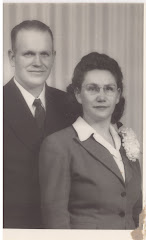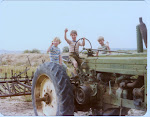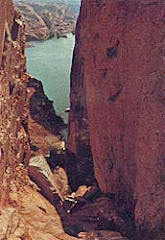 |
Mary Ann Ford Simmons
1827 - 1920 |
The Life of Mary Ann Ford Simmons
(As told by her) small changes to punctuation
Mary Ann Ford Simmons, the daughter of William and Mary Ann Knight Ford was born in Cucksfield Parish, Sussex, England on November 25, 1827. My parents belonged to the protestant church and made it a practice to go to church every Sunday. I did not go to Sunday School, as we lived four miles from church. I went to school and passed away my young days as most young people did.
I was quite religious for a child and often thought there was something wrong about the religions of the day. When I was about fifteen, my mother passed away; and when I was about sixteen the church men came around to hunt up the young people to be confirmed and belong to the church. I told them I did not wish to for I felt that there was something missing. After that I went to live with my brother in Brighton. It was a very large town. I went to all the chapels to hear what they preached; none of it sounded right. I felt it was not what I was looking for. I was honest, but I could not tell what I wanted to hear. Time passed. I left my brother's; hired some rooms, and started a school for small children, and took in needle work. After a time I was married to George Simmons - on the 24th of December 1849. Being a carpenter, he and his brother, William, used to take large jobs and hire men to work form them. They happened to get a Mormon to work for them and they talked for and against Mormonism. After a time my husband asked me to go and hear what they had to say. He was not at all religious. I went to hear them as soon as I could. When I heard them preach, I knew that it was what I had been looking for. I had a baby boy on the 12th of September, 1851, and the following year, on the 6th of September I was baptized, and on the 12th I was confirmed. My baby was blessed at the same time. He was one year old - by Henry Hollis. On the 18th of July 1853 I had a baby girl.
 |
Henry Hollis the Missionary who baptized
George and Mary Ann F. Simmons |
In 1854, April the 17th, we left Brighton for Liverpool: said good-bye to old England and set sail on the old ship Chimborazo, under the direction of Edward Stevenson. We went on the old tub as stowage passengers, and we did not have a very grand time - probably about the same as others in those days on sailing vessels. Sometimes there was too much wind, and at other times not any at all. I was very miserable from the first day to the last. When we landed at Philadelphia we enjoyed a good supper and breakfast.
 |
| Sailing Ship Chimborazo |
I think the next we went by train over the Alleghany Mountains. It was very bad and dangerous traveling, as the train was pulled up by ropes some way. We were traveling in cattle cars. I do not remember where we went next, but in time went on boat up the Mississippi River and the Missouri River. The joined together as you might put two flat pieces beside each other. One was as clear as could be and the other was thick as mud. We landed in the night at St. Louis. In the morning I took my little boy from the berth and he said: "Mama, we will go on shore, go into a house and have some dinner." He was three and a half years old. I did not think it could be true as we did not know any one there, but a brother we knew in England came on the boat (I do not remember his name) and took us back with him and we had a fine breakfast, dinner, and supper. So the child told the truth and we enjoyed it very much. The next day we went to the camping grounds called Mormon Grove. We were two weeks getting ready to start on the plains. There was another company camping there, and it was said they were from Texas. When the Saints were persecuted they went away. When things were quiet, they started to go to Utah, but the Lord stopped them - on their way they were taken down with cholera, and died in a few hours. They left the grove before we did. When we started we passed by their graves, five and six in one grave. The entire family of some passed away; all their things were put out of the wagons and left behind. They were lovely things too, but no one was allowed to pick them up. We traveled alone over hills and dales; sometimes the traveling was good, sometimes bad; but at all times, we thanked our Heavenly Father that we were on our way to Zion. Each day brought us nearer to our journey's end.
When we were about two days journey from Fort Laramie, a sister was making her bed in the wagon, a gun was there and it went off and shot her arm, breaking the bone half way between the shoulder and elbow. She ran out in camp with her arm swinging by a piece of flesh. They took her to Fort Laramie, but she died on the way. After we passed a day's journey beyond we were camped - I do not know what for- but we were surrounded with Indians, heaps of them. They were dressed up with paint and feathers; going to some great meeting. They wanted to trade ponies for white girls. A foolish young man was playing with his gun and it went off, and the red men went too. They were gone before you had time to look. When they found all was well, they came back again. I do not know what would have become of us if one of the had been shot. But it was a sister, and she was shot in the leg. They took her back to Fort Laramie, but she died. Her husband came on by another company.
As we were traveling west, we met the grasshoppers going east. For days we passed them, and they were so thick you could not seen the sun. They had eaten everything in Utah. I had a baby boy on the 16th of August, which lived about half an hour. After he was buried we started on our journey again. About a week or so later we had a stampede. It was dreadful to hear the oxen bellowing, the women and children screaming, and the wagons rattling as they were drug away. Our wagon did not. The men turned it on the side and stood around the oxen, and they did not start. I think if they had it would have killed me. No one in camp thought I would get to Salt Lake, but I did and am alive yet.
When we got to Salt Lake, our troubles were not ended. There was nothing to eat and no one had anything to spare, for the hoppers had eaten up everything. How we lived through the winder I could not tell. The Lord only knows. He blessed us or we could not have gotten through. We were without any fuel. The children and I had to sit on the bed with the bed clothes around us to keep us warm. We lived two months on frozen potatoes, taken from the top of a potato pit (they were badly frozen to), and the coarsest siftings of corn meal. Our neighbor used to make milk hot, thicken it with flour, and invite us to go to her house and have a good supper. She was Sophronia Martin. Her husband was on a mission. My little girl was sick all the winter and Sister Martin used to bring in a cup of milk every evening from the cow. In time she got all right.
When I got better that I could get around, I went all over town to try and get some needle work to do to get something to eat. I got a man's shirt to make. When spring came we went out to get segos. In time the garden stuff began to grow and we got beet greens. Things were getting better and work was to be had. I suppose we got along about as well as the others did. In the spring of 1857 we went to the Endowment House.
The Johnson Army was kept back an could not get to Salt Lake until the summer of 1858. They moved from the North to Salt Lake and then on to the south. On the 5th of June, I had a baby girl; she was one week old when they took me away to Provo during the "move." I was in the house of Sister Young, and remained there three weeks. My baby was a month old when we returned home. That was a great thing for all the people to move away to Provo and leave the city empty, with the exception of a few guards to take care of things.
 |
Johnston's Army marching though the nearly
deserted Salt Lake City. The Saints were
prepared to burn the city if necessary. |
In 1861 we moved to Morgan. There we had a log house with a dirt roof and floor. When it was raining and got through, it would still be raining in the house. For seven years we had the grass hoppers; one year they laid their eggs, the next they hatched out and in so doing they made us poor. One year we lost our crop by drought. We had to go 40 miles to Salt Lake to get matches or anything we needed. We had no money so we sent eggs and butter. We made soft soap or anything we had to trade. I had sheared the sheep, taken the wool and washed and picked it, carded it, and made into rolls; then spun it and made it into cloth and stocking yarn. We made our own soap. We had to make lye out of ashes, starch from potatoes, and molasses from beets. We had no sugar, so we made carrot preserve with molasses - and it was very nice. We had not fruit at first, but after a time we had apples, plums, gooseberries, currants, strawberries, and other kinds of fruit.
We had the first brick house in South Morgan. It had seven rooms. In March 1877, I was called to be the first counselor in the Relief Society of South Morgan Ward. In 1884 the Ward was reorganized. I had a brother married in Australia; they sent me money to go there to visit them so I resigned being counselor in the Stake in 1898. I had already made up my mind that if I came back all right. I was going to move to Salt Lake City to live - to work in the Temple. My husband passed away in September 1897. In May 1898 I went to Australia, and returned home in May 1899. In November I moved to Salt Lake. Before this I had been to the Logan Temple several times to work there. I joined the Genealogical Society to hunt up names. I did not find but a few so I had to send to an agent in England, a Brother Minns, for names of my relatives.
When my sister in law passed away, my brother sent for me again to go to Australia, and I went. They knew the first time that I was a Mormon, but a neighbor of my brother did not want me to come, so they were not backward in telling me what bad people the Mormons were. That was in the year 1908. My brother was rich in the things of this world. However, he disowned me and wanted me to go back home, which I did in 1909.
While I was yet there, however, I bought books and tracks from the Elders and went among the people to leave tracks with them, doing missionary work - the first one in Wellington, Australia. I took much pleasure in doing it. I converted one lady not long before coming away; I do not think she has been baptized, because her family was against it, but she still writes to me.
I returned to Salt Lake City and started again to work in the Temple. In 1914 my brother passed away. He did not give me a cent, although he had no other relatives but myself; he gave it all to those who were nothing to him.
 |
Mary Ann Ford Simmons
4 Generation |
I want to say and feel to say at all times that the Lord's will be done. I am now living in Farmington, Davis County in my 89th year. I have 12 children - seven are living, and five are dead. I have Seventy-three grandchildren - nine of which have passed away; and Eight-six great-grandchildren - seven of whom are dead; and one great-great grandchild.
--Farmington, Utah March 1916
|
 |
Death Certificate for Mary Ann Ford Simmons
July 13, 1920 Buried in South Morgan Cemetery
Morgan, Utah |
_________________________
Sources:
Family History Documents
FindaGrave.com
Ancestry.com























.jpg)







+Farm+Cowley,+Wyoming.jpg)
.jpg)







